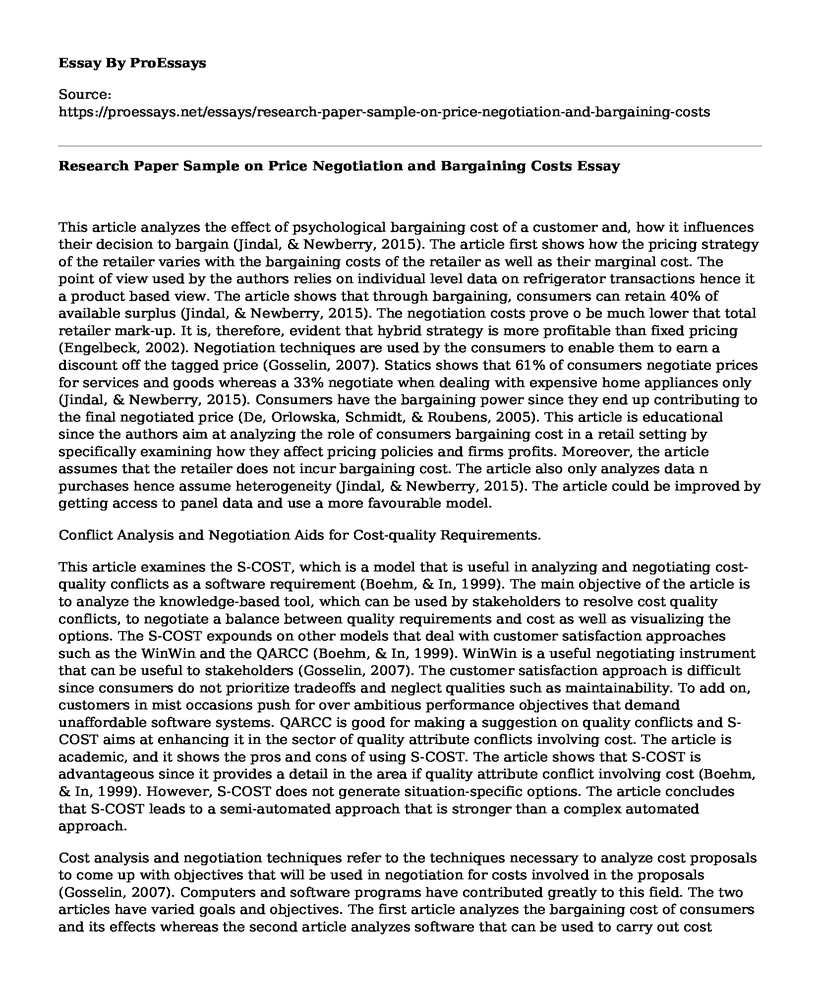This article analyzes the effect of psychological bargaining cost of a customer and, how it influences their decision to bargain (Jindal, & Newberry, 2015). The article first shows how the pricing strategy of the retailer varies with the bargaining costs of the retailer as well as their marginal cost. The point of view used by the authors relies on individual level data on refrigerator transactions hence it a product based view. The article shows that through bargaining, consumers can retain 40% of available surplus (Jindal, & Newberry, 2015). The negotiation costs prove o be much lower that total retailer mark-up. It is, therefore, evident that hybrid strategy is more profitable than fixed pricing (Engelbeck, 2002). Negotiation techniques are used by the consumers to enable them to earn a discount off the tagged price (Gosselin, 2007). Statics shows that 61% of consumers negotiate prices for services and goods whereas a 33% negotiate when dealing with expensive home appliances only (Jindal, & Newberry, 2015). Consumers have the bargaining power since they end up contributing to the final negotiated price (De, Orlowska, Schmidt, & Roubens, 2005). This article is educational since the authors aim at analyzing the role of consumers bargaining cost in a retail setting by specifically examining how they affect pricing policies and firms profits. Moreover, the article assumes that the retailer does not incur bargaining cost. The article also only analyzes data n purchases hence assume heterogeneity (Jindal, & Newberry, 2015). The article could be improved by getting access to panel data and use a more favourable model.
Conflict Analysis and Negotiation Aids for Cost-quality Requirements.
This article examines the S-COST, which is a model that is useful in analyzing and negotiating cost-quality conflicts as a software requirement (Boehm, & In, 1999). The main objective of the article is to analyze the knowledge-based tool, which can be used by stakeholders to resolve cost quality conflicts, to negotiate a balance between quality requirements and cost as well as visualizing the options. The S-COST expounds on other models that deal with customer satisfaction approaches such as the WinWin and the QARCC (Boehm, & In, 1999). WinWin is a useful negotiating instrument that can be useful to stakeholders (Gosselin, 2007). The customer satisfaction approach is difficult since consumers do not prioritize tradeoffs and neglect qualities such as maintainability. To add on, customers in mist occasions push for over ambitious performance objectives that demand unaffordable software systems. QARCC is good for making a suggestion on quality conflicts and S-COST aims at enhancing it in the sector of quality attribute conflicts involving cost. The article is academic, and it shows the pros and cons of using S-COST. The article shows that S-COST is advantageous since it provides a detail in the area if quality attribute conflict involving cost (Boehm, & In, 1999). However, S-COST does not generate situation-specific options. The article concludes that S-COST leads to a semi-automated approach that is stronger than a complex automated approach.
Cost analysis and negotiation techniques refer to the techniques necessary to analyze cost proposals to come up with objectives that will be used in negotiation for costs involved in the proposals (Gosselin, 2007). Computers and software programs have contributed greatly to this field. The two articles have varied goals and objectives. The first article analyzes the bargaining cost of consumers and its effects whereas the second article analyzes software that can be used to carry out cost analysis and improve on negotiation techniques. The first article is more of an academic piece but it reviews a product to collect its finding. The second article is more of an advertising price since it endorses the use of the software. The authors are however not based since they accept and show that the software has its limitations. The two articles, however, succeed in showing proper methods of cost analysis and the concepts of negotiation techniques.
References
Boehm, B. & In, H. (1999). Conflict Analysis and Negotiation Aids for Cost-quality Requirements. University of Southern California. Retrieved from http://csse.usc.edu/TECHRPTS/1999/usccse99-530/usccse99-530.pdf
De, S. H., Orlowska, E., Schmidt, G., & Roubens, M. (2005). Theory and Applications of Relational Structures as Knowledge Instruments. Berlin: Springer.
Engelbeck, R. M. (2002). Acquisition management. Vienna (VA: Management Concepts.
Gosselin, T. (2007). Practical negotiating: Tools, tactics, & techniques. Hoboken, N.J: John Wiley & Sons
Jindal, P. & Newberry, P. (2015). Price Negotiation and Bargaining Costs. The Pennsylvania State University. Retrieved from http://rady.ucsd.edu/docs/seminars/Jindal-Newberry-Bargaining-Costs-Apr2015.pdf
Cite this page
Research Paper Sample on Price Negotiation and Bargaining Costs. (2021, Jun 15). Retrieved from https://proessays.net/essays/research-paper-sample-on-price-negotiation-and-bargaining-costs
If you are the original author of this essay and no longer wish to have it published on the ProEssays website, please click below to request its removal:
- Communication in the Organizational Environment
- Case Analysis: A Remarkable Turn-Around
- Organizational Development OD Paper Example
- Essay Sample on Humility in Nursing Leadership
- Essay Sample on Information Security in Organizations
- Paper Example on Nonprofit Organizations' Productivity
- Free Paper on Apple's Supply Chain Vulnerabilities: Impact & Risk Strategies







